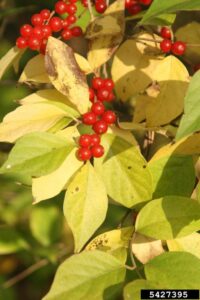Asian bush honeysuckle (Lonicera spp.) is an extremely invasive plant that is a serious problem in most areas of the Midwest. These invasive plants grow very fast, especially along woodland edges, and shade out most of the understory plants that are found in these areas. Honeysuckle can also significantly reduce the available browse for deer considering they don’t eat honeysuckle. Birds consume the fruit, bright red berries forming into early fall, which distributes seed to other areas. Due to the invasiveness of this weed, removal is highly recommended.
- Figure 1. Honeysuckle is easy to identify in the fall due to leaves that are very late to enter dormancy. Yellow leaves and red berries are prominent in late fall. Chris Evans, University of Illinois, Bugwood.org
Identification of Asian bush honeysuckle is easy in the spring due to being one of the first plants to leaf out and in the fall due to dropping of the leaves after most other species. Since these are the best times to identify honeysuckle, it also offers the best opportunity to eradicate the plants on the properties you manage.
Perennial weeds are susceptible to systemic herbicides any time of the growing season, but the fall is the most effective time to make herbicide applications due to the physiology of entering dormancy. During this time of year plants are storing carbohydrates into the roots and branches to prepare for the winter and subsequent growing season. Systemic herbicides applied at this time will effectively travel throughout the plant, thus killing or severely injuring the weed.
There are multiple ways to eradicate honeysuckle on your property, with the most effective combining physical injury with a systemic herbicide. Commonly called a cut-stump or a hack and squirt treatment, this method involves spraying herbicide after cutting the weed to the ground level or injuring the bark, respectively. It’s important to make the herbicide application immediately after physical injury so the weed doesn’t suberize, thus preventing the herbicide from easily accessing the vascular tissue. The two most common herbicides to eradicate honeysuckle by these two methods are glyphosate and triclopyr. Be sure to follow label directions when using any herbicides.
By spraying honeysuckle late in the season, you are less likely to injury other species since they will have lost their leaves and have entered dormancy. You may need make multiple applications, so check back early in the spring to ensure adequate efficacy on the fall treatments.
For further reading:
Asian bush honeysuckle
Invasive species: Asian bush honeysuckle
Now is the time to control bush honeysuckle
